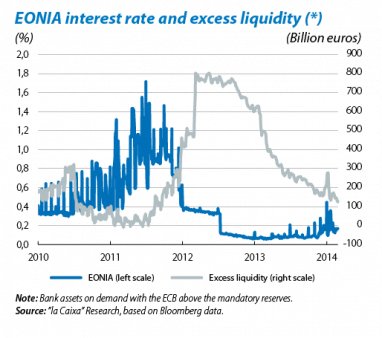The ECB's arsenal: slingshots and bazookas
On 6 February, the European Central Bank (ECB) decided to keep the parameters of its monetary policy unchanged. Although this came as no surprise, the possibility that it will adopt additional expansionary measures sooner rather than later has been dominating the attention of the markets for some weeks now. In fact, expectations are high for its meeting in March. The reasons that might push the ECB in such a direction are related to two issues of unequal substance. First and foremost is the risk of deflation still hovering over the euro area in a situation of incipient but vulnerable recovery. More limited and technical in scope are the tensions recently observed in interbank interest rates.
In the middle of last November, the very short-term interbank interest rates embarked on a volatile upward path, jeopardising the goal stated by the ECB to keep these stable, as close to zero as possible. The cause lies in the combination of two factors. First of all, the reduction in banks' excess liquidity at the ECB after paying back early the long-term loans they had received at the end of 2011. Ultimately, this development reflects the gradual resolution of the euro area's sovereign and bank debt crisis and is therefore reasonable. But it was intensified by the «year-end effect»: the desire by banks not to seem dependent on ECB funding, especially considering that their 2013 year-end balances will be the starting point for the bank solvency tests carried out by European authorities over the coming months.
Tensions failing to ease in January lead to more calls for the ECB to act. There is a long list of available measures to put a stop to this problem: lowering the interest rate for loans (now at 0.25%), relaxing the guarantees required for these, pushing the deposit facility rate into negative terrain (currently at 0%), reducing the amount of mandatory reserves, stopping the sterilisation of SMP bonds, etc. All these are technically, legally and politically feasible. And they would be highly effective, even more so when used in combination. It is likely that the ECB decided not to use them in February as it believed the tensions would tend to abate. Indeed, a notable improvement has been observed in the second half of the month. Such a delay could be helping to wear out the year-end effect and allow time for learning: interbank market agents, being used to an excessive amount of liquidity for several months now, may have been surprised by the sudden reduction in this liquidity and have taken time to adapt to a more normalised (but still relaxed) environment.
Whatever the case, the optimistic view is that the measures announced could relatively easily resolve episodes such as the one experienced. Using another instrument already employed in the past, such as long-term loans (LTRO), it would also be possible to keep monetary market interest rates close to zero in the case of more intense pressure.
However, there is a less encouraging view: these weapons seem too modest to avoid a possible increase in the risk of deflation once the so-called «zero lower bound» has been reached. At least compared with the arsenal we have seen deployed by the Fed and the Bank of Japan in the areas of quantitative easing and forward guidance. However, prior to any conceptual or practical considerations concerning their effectiveness, the big problem is that the ECB would encounter serious legal and political obstacles if it attempted to replicate the actions of these two central banks. This is indicated by the precedents. On the one hand, a situation of extreme urgency was required for the OMT programme to be approved, and not without objections from the Bundesbank and with an amber light given grudgingly by the German Constitutional Court. On the other, the proposal for the ECB to become involved, together with the EIB, in financing SMEs has been sidelined. Ultimately, and if the risk of deflation became more evident, the most likely outcome would be for the European authorities to take another step forward, supporting a sphere of action that would allow the ECB to implement decisive measures. At present, this does not seem likely given that the risk of deflation is not yet strong enough to get the political gears in motion. However, and partly precisely because of this, we cannot completely rule out the ECB resorting, in the near future, to some of the aforementioned light weaponry as a preventative measure that would signal to agents its intention to combat excessively low inflation.


